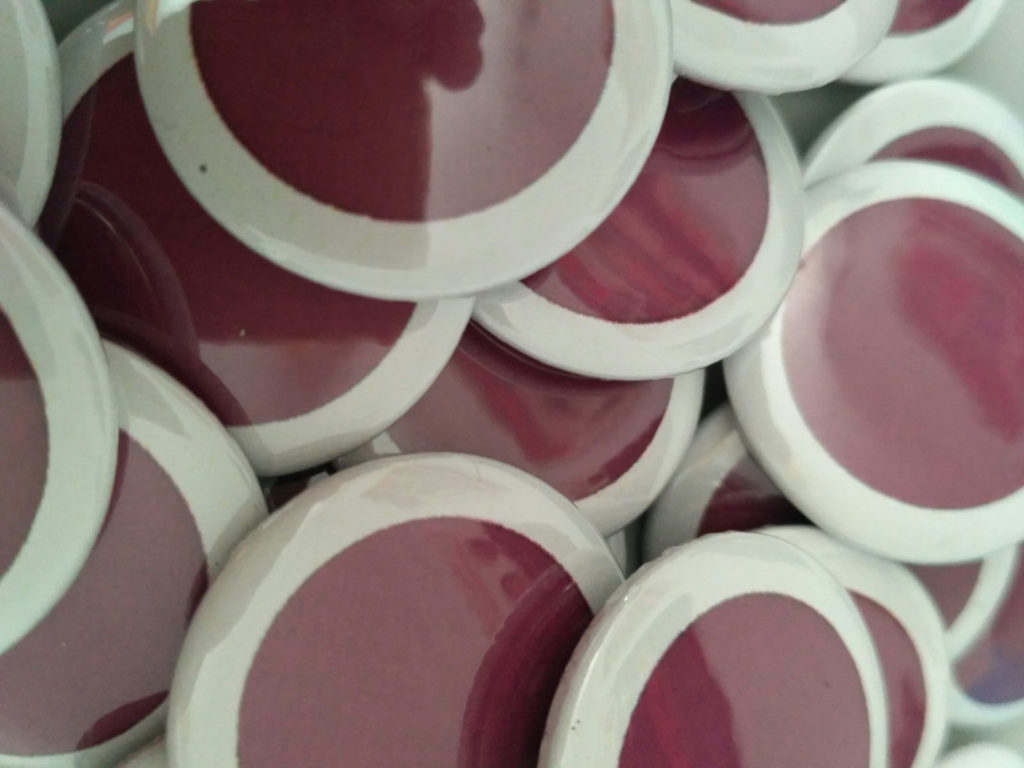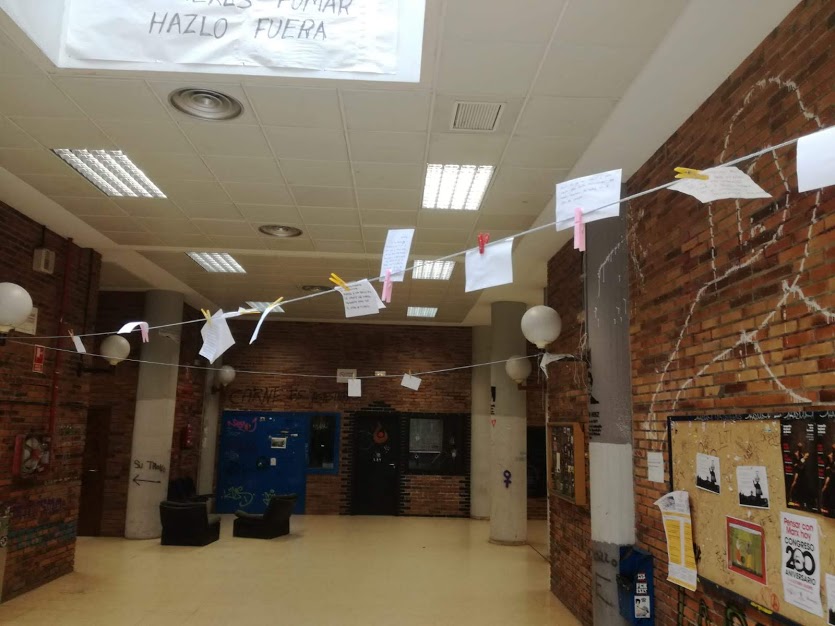26th April 2018, 15:00. A bunch of students and some academic staff, female and male, enter a classroom at the Faculty of Political Sciences and Sociology at Complutense University in Madrid. Smiles and waves are exchanged, occasionally nervous, while we sit in circle around the diaphanous space, as seats and tables have been pushed against the walls. After a while the group divides up in four, and each small group moves to a corner of the room. There, the groups prepare, using the technique of the theatre of the oppressed (Boal, 1974), everyday scenes of harassment at the University, and also the typical responses we tend to offer, both as co-students and academic staff. Body is placed on first line to generate a fiction where to rehearse possible solutions. Laughter, tears, and the so often felt outrage draw again in a sharp way while we revive scenes that have passed through our skins. Scenes that bring both shivers and disgust, and the memory of the impotence that we’ve felt all too often. Emotions that get stuck in our chests yet become political, all the while open to collective reflection. Together we learn from our own experiences of harassment and not the least from the way we’ve failed to give support. The feeling of being together and thinking together makes anger return to us as a political tool, transforming “silence into language and action” (Lorde, 1984:40): ¡Escucha, hermana, aquí está tu manada! [Listen, sister, here stands your pack!]. At the end of the meeting -a workshop on support strategies to sexual aggressions, sexual harassment, and harassment towards LGBTQI people-, the recently self-made chapas [pins] of the violet spot that we are collectively building are distributed among the volunteers. Through the low cost, low tech, analogical technology of the violet chapa [pin], we become mobile violet spots accessible to anyone requiring the support of the Somosaguas Violet Spot.

The Violet Spot have drawn strength from international mobilisations that make visible and denounce sexual harassment and sexual aggressions prevalent in the media and in the social networks worldwide in the last year – although many of them have a less well known story. #MeeToo in the English speaking world. #NiUnaMenos in Argentina and Latin America. #TomaFeminista, the feminist occupation of Universities in Chile against sexual harassment this May. #Cuéntalo, along with the mobilisations against the outraged trial and sentence in the collective rape case known as “La manada” [the pack], as well as the massive demonstrations of the 8th of march and the success of the feminist strike [#HuelgaFeminista #8M] in Spain. All of them are part of a new feminist global mobilisation wave that move online and offline crying out #YaBasta [#Enough].
The sexual harassment support workshop and the Somosaguas Violet Spot were born with the objective of making the University community as a whole responsible for the vulnerability, discomfort, violence and harassment that gender and LGBTQI people face in University campuses, whereas very often responsibility of the abuse seems to fall back into the assaulted person. We demand institutional responsibility, but we tried to go beyond the current Sexual Harassment and LGBTQI Harassment Protocol at Complutense University passed on 20th December 2016. The protocol treats accusations as isolated and exceptional, instead of recognising them as part of the “organisation culture” of the very institution, as Sarah Ahmed pointed out in her entrance on Sexual Harassment at her blog feministkilljoy, of 15th december 2015. Yet the protocol, now held as an institutional device, is the direct result of ongoing student mobilisations against sexual harassment at Complutense University in Madrid (UCM) initiated in 2013. An example of this mobilisation is the action that took place at the UCM Chancellor’s Office under the slogan “Nos desnudáis. Protocolo de acoso, ¡ya!” [You strip us. Harassment protocol, now!].
The protocol was achieved, but it participates of the institutional inertia, more interested in protecting the institution than the person denouncing, thus provoking revictimizations, invisibility and lack of institutional support. We could have bitterly asked ourselves with Sara Ahmed if the protocol has become a “mechanism of non-performativity”: “when naming something does not bring something into effect or (more strongly) when something is name in order not to bring something into effect” (Ahmed, 2017: 106-107).
Following Ahmed’s (2017) image, academic institutions -even apparently progressive ones- are part of a “brick wall” that reproduce inequality, and to take out one single brick of the wall requires of an almost heroic effort. #AllMalePanel has raised the issue of lack of female visibility in the Academia and how it very often works as an Old Boy’s Club, were women, LGBTQI, non conforming gender, racialized and functionally diverse people seems to be perpetually “out of place”. “Quiero ser libre no valiente” [“I want to be free, not brave”] was one of the slogans we sang in the different recent feminist demonstrations in Spain. Yet, setting up a sexual harassment complaint at University enhances insecurity and vulnerability. Not only because you need to testify again and again, but also since your testimony will be continuously put into question, as it is identified as an attack to the institution in the first place.
Providing evidence becomes, then, a key issue. “Matters of fact” become questionable biases constructions, or even “unfortunately misunderstandings” too seriously taken. One word against another. Yet, maybe, as Latour (2004) suggested we could move away from “matters of fact” to “matters of concern”, bringing to the fore the collective effort in sustaining current state of affairs in academic institutions and also assembling together the complex connections held to sustain the lives and bodies of the people harmed within institutional walls. Yet to make of sexual harassment a “matter of concern” is still not enough. We need to think about the assembled work of care required to sustain our lives (Puig de la Bellacasa, 2012; Tronto, 1993). To transform matters of fact into matters of care (Puig de la Bellacasa, 2011). Life entangles in strings that hold us as we also held them, both sustaining it and letting it go (Stengers, 2011). String figures using Haraway’s words that urge us to “cultivate response-ability” through a “collective knowing and doing, an ecology of practices” (Haraway, 2016: 34)
Thus, to resist collectively we have set our particular “string figure”. A rather ordinary clothesline at the entrance of the Students University Cafe. A clothesline to make visible sexual harassment. We have invited all passers-by to peg their own stories of harassment on the clothesline, as a washing out display to give presence to situations usually identified as absent. We wanted to wash out the silence that seems to ghost the university conjuring isolation into collective action. The narratives, many times dismissed as unreal, impossible to proof, take space and become visible, to be claimed as “matters of concern” (Latour, 2004). But the string that holds them together entails a collective effort and learning process. Both the clothesline and the Somosaguas Violet Spot are strings figures: collective caring devices both held by us but that hold us mattering care in particular ways to respond to the unavoidable demand of “staying with the trouble” (Haraway, 2016).


Acknowledgments: We would like to thank Maria Kristina Rustad Nordang for her committed English review of our article.
MerkenMerken